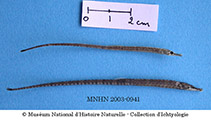| Family: |
Syngnathidae (Pipefishes and seahorses), subfamily: Syngnathinae |
| Max. size: |
16.5 cm SL (male/unsexed) |
| Environment: |
demersal; freshwater; brackish; depth range 10 - 13 m, |
| Distribution: |
Africa: Guinea (Ref. 28587, 57226, 81680) to the Congo River estuary, Democratic Republic of the Congo (Ref. 81680, 86940). Also reported from coastal Angola (Ref. 120641). Records of a specimen from marine waters off Punta Durnford are questionable. |
| Diagnosis: |
Dorsal spines (total): 0-0; Dorsal soft rays (total): 26-28; Anal spines: 0-0; Anal soft rays: 2-3. Diagnosis: 14-17 (median 16) pectoral fin rays; head length 6.5-7.5 (mean 7.1) times in SL (Ref. 57226, 81680). Snout tubular, moderately elongate (Ref. 57226), ratio head length/snouth length 1.8-2.3 (Ref. 57226, 81680).
Description: total number of rings 45-47 (Ref. 81680), 13-14 trunk rings (before anus) and 32-34 tail rings (behind anus)(Ref. 57226, 81680). 5.5-6.25 subdorsal rings; dorsal fin origin from anterior margin to middle of first tail ring, usually at anterior margin; snout length positively allometric; caudal fin with 9 rays (Ref. 81680). Male brood pouch extending on (15) 16-18 rings of the tail (Ref. 57226, 81680).
Coloration: In life: generally greyish/dusky with a brick-red abdomen; lower flanks yellowish grey with a golden black margined ocellus on each ring; caudal fin black with a pale edge (Ref. 57226, 81680). Head plain in males, with black bars below eye and on lower part of opercle in females; tail rings spotted black, sprinkled with gold (Ref. 81680). Preserved specimens: each trunk ring with a black bordered brown spot extending dorsal from inferior ridge; pouch plates of males with a series of alternating short, pale, brownish bars (Ref. 57226, 81680). Sometimes dorsum and upper flanks crossed by about 10 narrow, diffuse, pale bars (Ref. 81680). |
| Biology: |
Occurs in coastal rivers and estuaries (Ref. 4127). Seems to be mainly a brackish water species, only occasionally entering fresh water (Ref. 81680). Has been recorded in waters with a temperature range of 26.0-29.0 °C (Ref. 4959). Lives among algae where it mimics the coloration of the vegetation. Feeds on small prey and organic debris. Ovoviviparous (Ref. 205). The incubation of the eggs takes place in a marsupial pouch found in front of the tail of the males (Ref. 5377). Dawson (1981) reported over 800 postlarvae in a male of 141 mm SL (Ref. 81680). Maximum reported total length 20.0 cm (Ref. 5377). |
| IUCN Red List Status: |
Least Concern (LC); Date assessed: 07 June 2016 Ref. (130435)
|
| Threat to humans: |
harmless |
| Country info: |
|
Source and more info: www.fishbase.org. For personal, classroom, and other internal use only. Not for publication.

